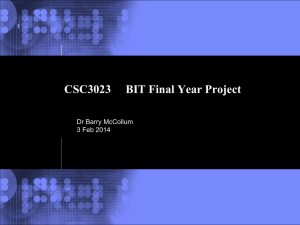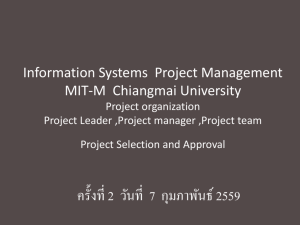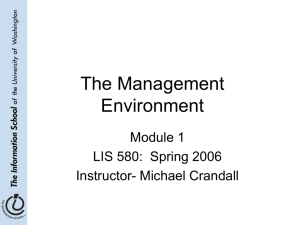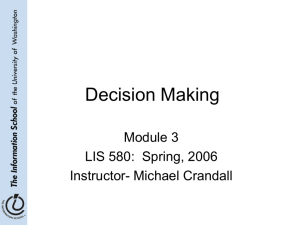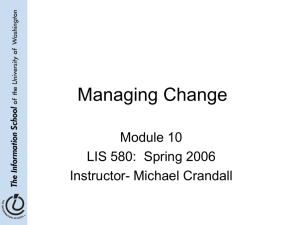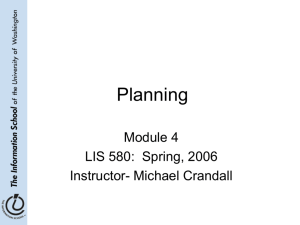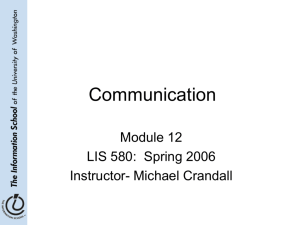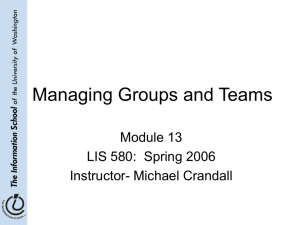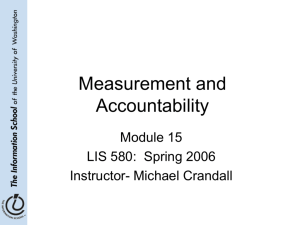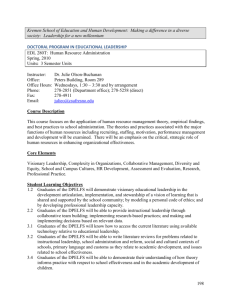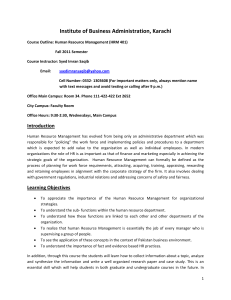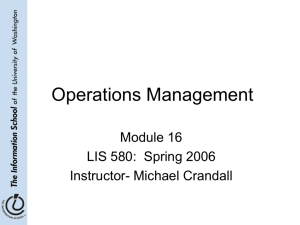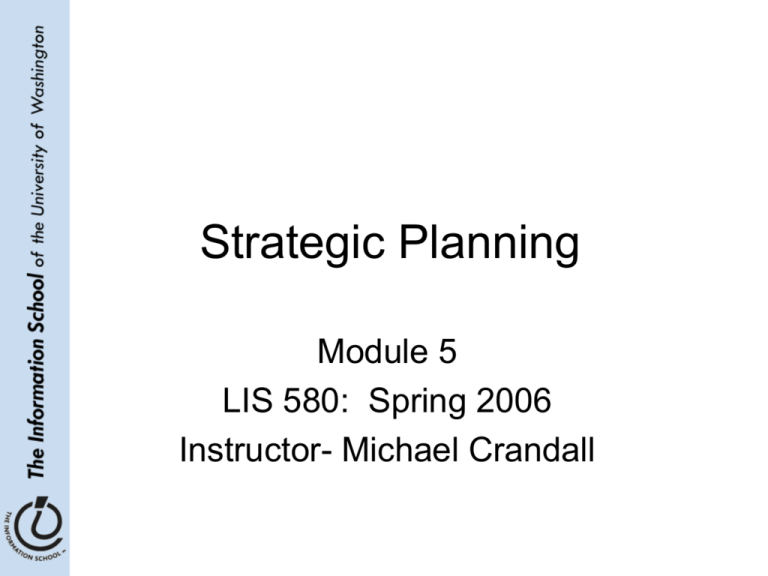
Strategic Planning
Module 5
LIS 580: Spring 2006
Instructor- Michael Crandall
Roadmap
•
•
•
•
•
The strategic management process
Mission and vision statements
Analyzing strategic drivers and core
competencies
SWOT analysis
Scenario planning
April 11, 2006
LIS580- Spring 2006
2
Checklist 5.1
The Strategic Management Process
Define the business and its mission.
Perform external and internal audits.
Translate the mission into strategic
goals.
Generate and select strategies to
reach strategic goals.
Implement the strategy.
Evaluate performance.
G.Dessler, 2003
April 11, 2006
LIS580- Spring 2006
3
A Comprehensive StrategicManagement Model
Source: Adapted from Fred David, Strategic Management (Upper Saddle River, NJ: Prentice-Hall, 2001), p. 77.
April 11, 2006
LIS580- Spring 2006
FIGURE 5–1
G.Dessler, 2003
4
Vision and Mission
• A vision statement tells people
–
–
–
–
Where we want to go
What we want to become
What we want to accomplish
Why it is important
• And a mission expresses the organization’s:
– Purpose - the needs we exist to address
– Business - what are we doing to address these
– Values - what principles or beliefs guide our work
April 11, 2006
LIS580- Spring 2006
5
Examples of Mission Statements
APEX ELEVATOR
To provide a high-reliability, error-free method for moving people and
products up, down, and sideways within a building.
UNITED TELEPHONE CORPORATION OF DADE
To provide information services in local-exchange and exchange-access
markets within its franchised area, as well as cellular phone and paging
services.
JOSEPHSON DRUG COMPANY, INC.
To provide people with longer lives and higher-quality lives by applying
research efforts to develop new or improved drugs and health-care
products.
GRAY COMPUTER, INC.
To transform how educators work by providing innovative and easy-to-use
multimedia-based computer systems.
FIGURE 5–2
April 11, 2006
LIS580- Spring 2006
G.Dessler, 2003
6
Strategies in Brief
COMPANY
STRATEGIC PRINCIPLE
America Online
Consumer connectivity first—anytime, anywhere
Dell
Be direct
eBay
Focus on trading communities
General Electric
Be number one or number two in every
industry in which we compete, or get out
Southwest Airlines
Meet customers’ short-haul travel needs at fares
competitive with the cost of automobile travel
Vanguard
Unmatchable value for the investor-owner
Wal-Mart
Low prices, every day
Source: Arit Gadiesh and James Gilbert, “Frontline Action,” Harvard Business Review, May 2001, p. 74.
FIGURE 5–3
G.Dessler, 2003
April 11, 2006
LIS580- Spring 2006
7
Checklist 5.2
How to Test the Quality of Your
Strategy
Does your strategy fit with what’s going on in
the environment?
Does your strategy exploit your key resources?
Will competitors have difficulty keeping up with
you?
Are the elements of your strategy internally
consistent?
Do you have enough resources to pursue this
strategy?
Can your strategy be implemented?
G.Dessler, 2003
April 11, 2006
LIS580- Spring 2006
8
Relationships Among Strategies
in Multiple-Business Firms
FIGURE 5–4
G.Dessler, 2003
April 11, 2006
LIS580- Spring 2006
9
Strategy Types
• Corporate
–
–
–
–
–
–
Concentration
Vertical integration
Diversification
Status quo
Investment reduction
Strategic alliances/joint ventures
• Competitive
– Cost leadership
– Differentiation
– Focus
April 11, 2006
LIS580- Spring 2006
10
Forces Driving Industry Competition
Source: Reprinted with the permission of The Free Press, a division of Simon & Schuster from Competitive Strategy:
Techniques for Analyzing Industries and Competitors by Michael E. Porter. Copyright © 1980 by The Free Press.
April 11, 2006
LIS580- Spring 2006
FIGURE 5–5
G.Dessler, 2003
11
How the Internet Influences Industry
Structure
Source: Adapted from
Michael Porter,
“Strategy and the
Internet,” Harvard
Business Review,
March 2001, p. 67.
April 11, 2006
FIGURE 5–6
G.Dessler, 2003
LIS580- Spring 2006
12
Examples of a Company’s Strengths,
Weaknesses, Opportunities, and
Threats
FIGURE 7–7
G.Dessler, 2003
April 11, 2006
LIS580- Spring 2006
13
Worksheet for Environmental Scanning
FIGURE 5–8
G.Dessler, 2003
April 11, 2006
LIS580- Spring 2006
14
Checklist 5.3
How to Benchmark
Focus on a specific problem and define it
carefully
Use employees who will actually
implement changes to identify the bestpractices companies and to conduct onsite studies.
Be willing to share information with others.
Avoid sensitive issues such as pricing, and
don’t look for new product information.
Keep information you receive confidential.
G.Dessler, 2003
April 11, 2006
LIS580- Spring 2006
15
Cineplex Odeon TOWS Matrix
Source: Fred
David, Strategic
Management
(Upper Saddle
River, NJ:
Prentice-Hall,
2001), p. 207.
April 11, 2006
FIGURE 5–9
G.Dessler, 2003
LIS580- Spring 2006
16
BCG Matrix
FIGURE 5–10
G.Dessler, 2003
April 11, 2006
LIS580- Spring 2006
17
Checklist 5.4
Scenario Planning Principles
Scenarios have value only to the extent that
they inform decision makers and influence
decision making.
Scenarios add value to decision making only
when managers and others use them to
systematically shape questions about the
present and the future, and to guide how to go
about answering them.
In each step of developing scenarios, the
emphasis must be on identifying, challenging,
and refining the substance of managers’
mindsets and knowledge.
G.Dessler, 2003
April 11, 2006
LIS580- Spring 2006
18
Checklist 5.4 (cont’d)
Scenario Planning Principles
Alternative projections about a given future
must challenge managers’ current mental
models by creating tension among ideas,
hypotheses, perspectives, and assumptions.
The dialogue and discussion spawned by the
consideration of alternative futures should
directly affect managers’ knowledge.
Scenarios should include enough indicators
so that managers can track how the future is
actually evolving so that the learning and
adaptations stimulated by the scenarios are
continuous.
G.Dessler, 2003
April 11, 2006
LIS580- Spring 2006
19
Southwest Airlines’ Activity System
Source: Reprinted by permission of Harvard Business Review. From “What Is Strategy?” by Michael E. Porter,
November–December 1996. Copyright © 1996 by the President and Fellows of Harvard College; all rights reserved.
April 11, 2006
LIS580- Spring 2006
FIGURE 5–11
G.Dessler, 2003
20
Strategic Fit vs. Stretch
• Southwest follows Michael Porter’s view
that functional strategies should support
corporate and competitive strategies
• Hamel and Prahalad argue that
leveraging resources is more important
for long-term success
• Core competencies define key strengths
of the organization, and provide the
focus for strategic choices
April 11, 2006
LIS580- Spring 2006
21
Cleveland Public Library
• How did the library go about building their
plan?
• Did they effectively engage the stakeholders
in the process?
• What kinds of outside help did they seek in
formulating their plan?
• How did the concrete steps they defined
relate to their mission and vision statements?
• Were there any measurements of success
built into the plan?
April 11, 2006
LIS580- Spring 2006
22
Next Time
•
Guest lecture
– Mike Eisenberg, Dean Emeritus, the Information
School
•
Read the iSchool Strategic Plan Mike wrote
in 1998, and think of it in the context of the
discussions we’ve been having over the past
several days
– Come prepared with questions that use class
readings and discussion to examine this plan
– A great chance to hear from someone who’s gone
through a full planning cycle
April 11, 2006
LIS580- Spring 2006
23

